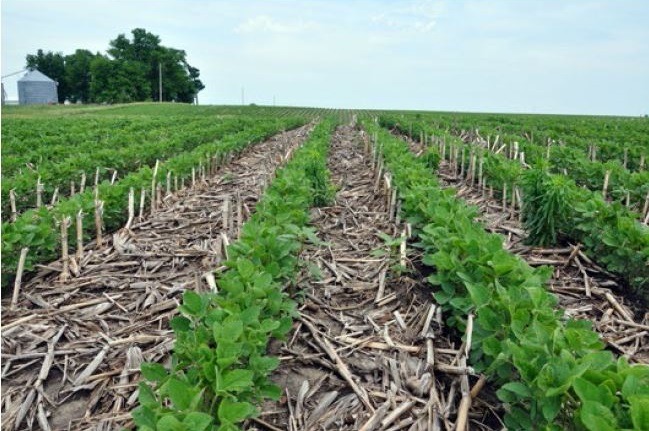
no till farming 1.jpg
No-Till Farming: Cultivating Conservation and Sustainability
Definition:
No-till farming, also known as zero tillage or direct seeding, is an agricultural practice that involves planting crops into untilled soil without prior plowing or cultivation. Instead of disturbing the soil with traditional tillage equipment, farmers utilize specialized seeding equipment to sow seeds directly into the residue-covered soil surface.
The Principles of No-Till Farming:
No-till farming is based on the principles of minimal soil disturbance, soil cover, crop rotation, and precision farming technologies. By avoiding tillage, farmers aim to preserve soil structure, reduce erosion, enhance soil health, and improve water and nutrient management in agricultural landscapes.
Fall off the barn roof and busted your keister? Life on the farm or ranch can be tough on the bum. Need a break? Laugh it off at FarmerCowboy.com, the #1 farm humor site. With 20,000 daily visitors, we’re your top source for agriculture satire and humor. Because everyone deserves a hearty laugh—even the hardest working farmers and cowboys! Join us and turn those long days into fun tales at FarmerCowboy.com.
Key Components of No-Till Systems:
Successful implementation of no-till farming requires careful attention to several key components, including:
- Crop Residue Management: Maintaining a protective cover of crop residues on the soil surface is essential for preventing erosion, conserving soil moisture, and suppressing weed growth. Crop residues also contribute organic matter to the soil, enhancing soil fertility and microbial activity.
- Equipment Adaptation: No-till farming often requires specialized equipment, such as no-till seed drills, planters, and residue management tools, designed to operate effectively in untilled soil conditions. These equipment adaptations help to ensure accurate seed placement, optimal seed-to-soil contact, and efficient residue management.
- Weed Management Strategies: No-till systems rely on integrated weed management strategies, including herbicide use, crop rotation, cover cropping, and mechanical weed control, to manage weed populations and prevent weed-related yield losses. Crop rotation and diverse cover crop mixtures can help suppress weed growth and reduce herbicide reliance in no-till systems.
Benefits of No-Till Farming:
No-till farming offers numerous benefits for soil health, water conservation, carbon sequestration, biodiversity conservation, and farm profitability, including:
- Soil Conservation: No-till farming reduces soil erosion, preserves soil structure, and enhances soil organic matter content, improving long-term soil health and productivity.
- Water Management: No-till systems improve water infiltration, reduce runoff, and enhance soil water retention, helping to mitigate the impacts of drought and water scarcity.
- Carbon Sequestration: By minimizing soil disturbance and increasing soil organic matter levels, no-till farming promotes carbon sequestration in agricultural soils, mitigating greenhouse gas emissions and climate change.
- Biodiversity Enhancement: No-till systems support diverse soil microbial communities, beneficial insects, and wildlife habitats, promoting ecological resilience and biodiversity conservation.
- Economic Benefits: While transitioning to no-till farming may require initial investment in equipment and management practices, the long-term benefits include reduced input costs, improved crop yields, and enhanced farm profitability.
Challenges and Considerations:
Despite its numerous benefits, the adoption of no-till farming may face challenges related to equipment costs, weed management, crop residue decomposition, and farmer education and support. Addressing these challenges requires collaborative efforts among farmers, researchers, policymakers, and agricultural stakeholders to promote the widespread adoption and implementation of no-till farming practices.
Conclusion:
In conclusion, no-till farming represents a sustainable approach to soil management and crop production that prioritizes soil conservation, environmental stewardship, and farm profitability. By embracing the principles of no-till farming, farmers can protect soil resources, enhance ecosystem services, and promote the long-term sustainability of agricultural systems.
References:
- United States Department of Agriculture. (2020). No-Till Farming. https://www.nrcs.usda.gov/wps/portal/nrcs/main/national/programs/soilhealth/notill/
- Soil and Water Conservation Society. (n.d.). No-Till Farming. https://www.swcs.org/resources/no-till-farming/
- Sustainable Agriculture Research & Education. (n.d.). No-Till Farming. https://www.sare.org/Learning-Center/Books/Building-Soils-for-Better-Crops-3rd-Edition/Text-Version/No-Till-Farming/
Originally posted 2011-08-03 22:54:11.
Originally posted 2024-06-21 11:39:27.
Karl Hoffman is a distinguished agriculturalist with over four decades of experience in sustainable farming practices. He holds a Ph.D. in Agronomy from Cornell University and has made significant contributions as a professor at Iowa State University. Hoffman’s groundbreaking research on integrated pest management and soil health has revolutionized modern agriculture. As a respected farm journalist, his column “Field Notes with Karl Hoffman” and his blog “The Modern Farmer” provide insightful, practical advice to a global audience. Hoffman’s work with the USDA and the United Nations FAO has enhanced food security worldwide. His awards include the USDA’s Distinguished Service Award and the World Food Prize, reflecting his profound impact on agriculture and sustainability.




